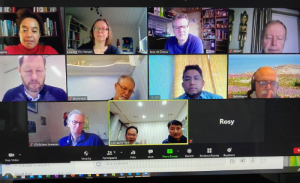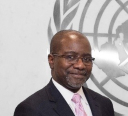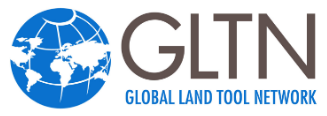News in 2020

|
UN-Habitat-GLTN partners online-meeting
December 2020
FIG Partnership Working:
-
GLTN Steering Committee Meeting, 30th November 2020, and
-
Global Land Tool network 8th Partners Meeting 2020: “Tenure Security as a key element of COVID-19 response and impact
on mitigation”
1 - 4 December 2020

UN Habitat Headquarters, Nairobi |
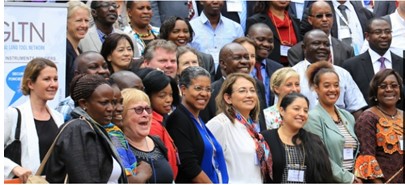
Participants at the GLTN Partners meeting (2018)
|
FIG Vice President Diane Dumashie attended the GLTN steering
committee held on 30th November 2020. This was followed by attendance at
the four day partner meeting starting on Tuesday 1st December 2020,
along with Louise Friis-Hansen.
The GLTN partners’ meeting is the opportunity for all members to meet
every two years to discuss strategy. Led by the GLTN secretariat it is
usually held at the UN Habitats HQ, in Nairobi, Kenya. Not
surprisingly the 2020 meeting was held online. The meeting aims to
enable networking, provide a comprehensive update and to ensure that the
members are fully engaged in the work plan.
FIG Council continues to see this network as an important and encourages
and facilitates member’s significant and ongoing contribution to the
development of the network aims.
The objectives for the 8th GLTN partners’ meeting are to:
- Governance: To fulfil the requirements of the
Partners’ Charter regarding the election of cluster leads and to convene
the GLTN Steering Committee.
- Partner discussions: To provide an
opportunity to share and discuss experiences, trends and tools related
to land tenure security;
- Work Planning: To reflect on project
implementation linked to the GLTN Phase 3 strategy, and announce the
call for projects proposals, requesting ideas from FIG members by 15th
January 2021.
This report is divided into three parts, it summarises the five days of
deliberations in line with the above objectives. The full schedule
of sessions and events is captured in the image at the footer.
1. Governance and the Steering committee
GLTN is a dynamic alliance of more than 80 global land actors and
stakeholders working together, FIG being one of the originating partner
members. It was launched in 2006 in response to critical gaps in land
governance and administration approaches, tools and systems, to deliver
land tenure security at scale.
GLTN currently is working within Phase 3 Strategy (2018-2030)
emphasising that partners work together to develop and implement
inclusive, fit-for-purpose and gender-responsive land tools to improve
living conditions for all, prioritizing women, youth and vulnerable
groups in both urban and rural settings.
Every year the steering committee meets with the purpose to help guide
and provide oversight to the activities and also to ensure that the
members are fully engaged in the work plan. The GLTN partners are
grouped into clusters of like-minded organisations; FIG is a member of
the Professional cluster, (the other clusters are Academic/ Rural civil
society/ Urban civil society).
The Steering Committee comprises of two co- chairs from each cluster,
who are voted into office for a 2 year period. The voting at the
cluster meeting on 3rd December resulted in Diane Dumashie (FIG) and
Rafic Khoiir (Arab Union of Surveyors) re- elected for the 2 year period
ending December 2022.
A key agenda item included the results of an independent interim review
of the current GLTN phase 3 strategy, covering the first 18 months.
The report concluded that progress is good and work on track as the
network continues to work though the plan period. Further the
independent assessor was impressed by country level implementation,
capacity development initiatives, the suite of E learning products now
available and the ever increasing tools, many of which FIG members are,
and continue to be involved. The report was presented to all
partners in session 3.
2. Partners discussions
The four day meeting is designed to encourage partner commitment and
engagement with the GLTN Phase 3 agenda and to facilitate the vibrancy
and reciprocity of the GLTN partnership. Clearly the online format
had some constraints in networking but it did maximise the number of
people able to attend.
https://gltn.net/8th-gltn-partners-meeting-2020/#tab-overview

With 6 sessions and 5 side events the following documents Diane
Dumashie’s engagement- the full list of events may be found at:
https://gltn.net/8th-gltn-partners-meeting-2020/#tab-5fabfbaca8188
Side Event: Collecting best practices
Fit-For-Purpose Land Administration (FFP) & STDM
This was one of the stand-out events of the meeting. Designed and led by
Paula Dijkstra (Kadaster International) and supported by partners
Kadaster, ITC, Cadasta Foundation ITC/University of Twente/Volunteer
Community Surveyor Programme and FIG.
Read side event report
Diane Dumashie’s introductory remarks that FFP LA and STDM approaches
are effective bridging mechanisms for cooperation set the scene for rich
discussions. A proactive and engaging event ensued with a focus on
how to collect experiences and lessons learned from projects around the
world. The deliberations will contribute to a publication on
implementation of FFP LA.
Side Event: Book
launch – ‘Land Issues in Urban Governance in Sub-Saharan Africa’ ed
editor, Professor Robert Home
A volume of 20 papers it explores the challenge that by 2030 Africa’s
urban population will exceed half of its total population, and will
require infrastructure, social services, affordable housing and
employment opportunities, which all depend upon land. The book is one
in a series by Springer Nature on Local and Urban Governance
Session 1: Taking stock
Session 4 Going
forward:
- In line with the
meeting focus on the Network strategic decisions and policy directions
this session considered: What do we as partners need to be doing to
achieve effective project success in the reminder of the Phase 3
Strategy 2018-2030.
- Diane Dumashie (FIG)
and Jaap Zevenbergen (University of Twente) were asked to be panellist
and to open the discussion with their ideas.
- Key take always on:
- Connectivity: It is not only about networking
amongst our own clusters; but actually meaningfully connecting to
facilitate relationships that work across clusters. To take our
tools to scale then we need a diversity of actors across our land
communities.
- Technological innovation: crossing information and
communication. Technology is the path to power. Our goal is to be
adaptive and agile; but we need equality in how technology is accessed,
in both urban and rural communities. Our further goal is leave no one
behind in the scramble to be digitally connected.
Session 5 Professionals Cluster Administration/ meeting
- The author extends
thanks to the professional cluster members and their representatives for
attending both the professional cluster pre- meeting on 24th November
and the Cluster meeting on 3rd December.
- The administration
meeting held on Thursday 3rd December included: FIG (in the chair),
CLSPI, Kadaster, FGF, RICS, GLTN, CASLE. Aplogises from OSGeo, and AU
- Taking the chair of
the meeting, Diane Dumashie steered the attendees into a discussion on
present and future work plan initiatives. This blue sky thinking
begins to articulate project ideas for the upcoming work plan, discussed
next.

Professional cluster pre- meeting on Tuesday 24th November, Photo L Friis-Hansen
3. Project work planning
Present (Year 2020):
Over the period 2018 to 2020 the professionals cluster contribution
has remained high, and continues to be at the forefront of GLTN
activities; on land tool development, on testing and dissemination
innovative methods, and promoting and facilitating the adoption at scale
of land tools and practices that promote tenure security and to develop
the capacity needed for fit for- purpose implementation (see
presentation).
Led by our Council, FIG has been actively engaged, in particular
rolled-out by:
- Commission 7 led by Daniel Paez: Conceptualising Urban Rural
Land Interrelationships, and
- Commission 9 led by James Kavanagh: A manual on Valuing
Unregistered Lands.
Future (Year 2021 to 2022)
The funding project cycle has been confirmed by GLTN secretariat. This
means that the Cluster work plans for the period June 2021 to December
2022 will be drafted and finalized in the next 3 months (end March
2021).
Cluster members need to consider what, if any projects they would like
to promote and progress during June 2021 to December 2022. It is
important that any projects align with the current GLTN phase 3
strategy.
The next step is to collate ideas for project consideration and requires
ideas from FIG members to be submitted by 15th January 2021
to FIG
office
louise.friis-hansen@fig.net or
ddd@dumashie.co.uk
4. Final words:
The partner meeting was closed by Mr Victor Kisob, Deputy Executive
Director of UN Habitat. Noting that the GLTN Partners’ Meeting in 2020
happens at a most vulnerable and critical time in the recent human
history. The global pandemic has posed tremendous challenges on
governments, even more so in developing countries. Now, more than ever,
collaboration and partnerships among many different sectors and actors
are necessary. The work of Global Land Tool Network partners on security
of tenure, housing rights and combatting forced evictions can help
governments to develop effective policy measures and collaborative
solutions in this respect.
Mr Victor Kisob, Deputy Executive Director of UN
Habitat
The author sincerely thanks our FIG members who were able to take part
in these difficult times. FIG members remain a key part of the
GLTN network, and working together with partners both in the
Professional cluster and across to the other clusters (such as Urban,
Rural and Academic clusters). We are strategically placed to help
countries deliver on land projects steered by the GLTN Strategy
documents and our own FIG work plans.
Author FIG Vice President Diane Dumashie (Co- chair GLTN Professional
Cluster)
* Members of the Steering Committee: • UN-Habitat (Deputy Executive
Director) • International Federation of Surveyors • University of East
London • Technical University of Munich • Huairou Commission • Asian
Coalition for Agrarian Reform and Rural - Development (ANGOC) • Habitat
for Humanity• Slum Dwellers International • Arab Union of Surveyors •
Representative of Member States • Development Partners
Resources Institutions: • International Land Coalition, • Land Tenure
Facility, • GLTN Secretariat
Global Land Tool network 8th Partners
Meeting 2020:
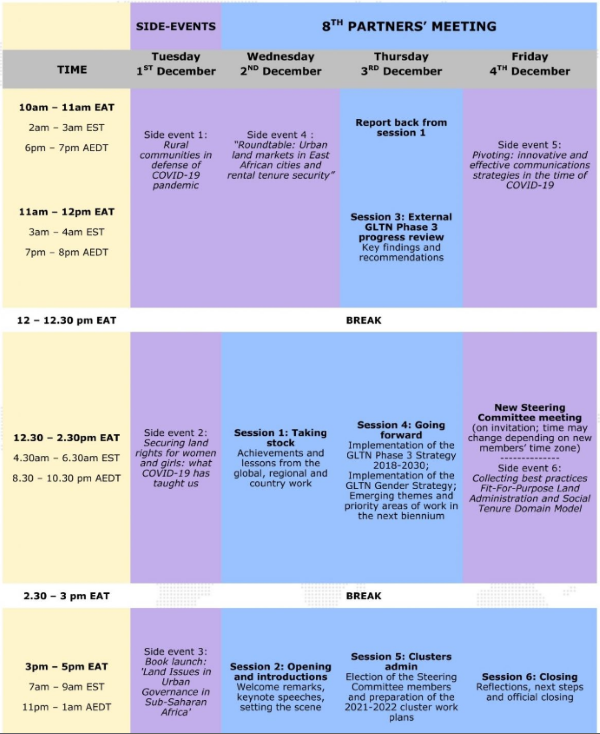
Diane Dumashie
December 2020























